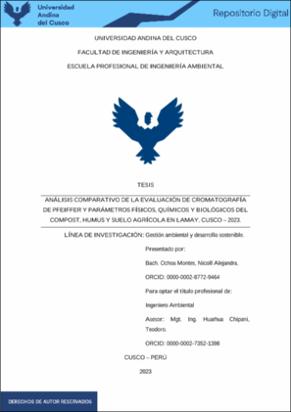| dc.contributor.advisor | Huarhua Chipani, Teodoro | |
| dc.contributor.author | Ochoa Montes, Nicoll Alejandra | |
| dc.date.accessioned | 2023-12-29T17:32:47Z | |
| dc.date.available | 2023-12-29T17:32:47Z | |
| dc.date.issued | 2023-10-25 | |
| dc.identifier.uri | https://hdl.handle.net/20.500.12557/6016 | |
| dc.description.abstract | La técnica de cromatografía de Pfeiffer es una herramienta sencilla y asequible, el
objetivo principal fue comparar los resultados de la evaluación cualitativa de
cromatografía de Pfeiffer y el análisis de parámetros físicos, químicos y biológicos del
compost, humus y suelo agrícola en Lamay. La metodología de trabajo se basó en la
extracción de muestras de compost, humus y suelo agrícola a una profundidad de 0 a 40
cm, como reactivos para la preparación de muestras se utilizó hidróxido de sodio (NaOH)
y para la preparación del filtro Whatman se empleó nitrato de plata (AgNO3),
posteriormente se realizó el análisis cromatográfico y los resultados fueron comparados
con la Norma Chilena NCh - 2880.2004 para compost, Norma Mexicana NMX-AA-180-
SCFI-2018 para humus y el Decreto supremo N.º 005 – 2022 – MIDAGRI para suelo
agrícola con la finalidad de analizar la calidad de las muestras. El análisis estadístico
empleado fue ANOVA con probabilidad de 0.05 utilizando la prueba de medias de Tukey
al 95 % de confiabilidad. Como resultados se obtuvieron que el compost es de calidad
óptima, comprendiendo como zonas más significativas la zona interna y central del
cromatograma cumpliendo con la norma para compost, el humus es de calidad óptima,
teniendo como zona más significativa la zona interna del cromatograma, cumpliendo con
la norma para humus como fertilizante orgánico y el suelo agrícola es de calidad mala
considerando como zona más significativa la zona interna del cromatograma. Se concluye
que la técnica de cromatografía de Pfeiffer es de utilidad para determinar la calidad del
compost, humus y suelo agrícola. | es_PE |
| dc.description.abstract | The Pfeiffer chromatography technique is a simple and affordable tool, the main
objective was to compare the results of the qualitative evaluation of Pfeiffer
chromatography and the analysis of physical, chemical and biological parameters of
compost, humus and agricultural soil in Lamay. The work methodology was based on the
extraction of samples of compost, humus and agricultural soil at a depth of 0 to 40 cm.
Sodium hydroxide (NaOH) was used as reagents for sample preparation and for the
preparation of the Whatman filter. silver nitrate (AgNO3) was used, and then subjected
to chromatographic analysis, the results were compared with the Chilean Standard NCh -
2880.2004 for compost, Mexican Standard NMX-AA-180-SCFI-2018 for humus and
Supreme Decree No. 005 – 2022 – MIDAGRI for agricultural land in order to analyze the
quality of the samples. The statistical analysis used was ANOVA with probability of 0.05
using Tukey's test of means at 95% reliability. As results, it was obtained that the compost
is of optimal quality, with the most significant zones being the internal and central zone
of the chromatogram, complying with the standard for compost, the humus is of optimal
quality, having the internal zone of the chromatogram as the most significant zone,
complying with with the norm for humus as organic fertilizer and the agricultural soil is
of poor quality, considering the internal zone of the chromatogram as the most significant
zone. It is concluded that the Pfeiffer chromatography technique is useful to determine
the quality of compost, humus and agricultural soil. | en_US |
| dc.format | application/pdf | es_PE |
| dc.language.iso | spa | es_PE |
| dc.publisher | Universidad Andina del Cusco | es_PE |
| dc.rights | info:eu-repo/semantics/restrictedAccess | es_PE |
| dc.rights.uri | https://creativecommons.org/licenses/by-nc-nd/4.0/ | es_PE |
| dc.subject | Cromatografía de Pfeiffer | es_PE |
| dc.subject | Zonas del cromatograma | es_PE |
| dc.subject | Suelo agrícola | es_PE |
| dc.title | Análisis comparativo de la evaluación de cromatografía de Pfeiffer y parámetros físicos, químicos y biológicos del compost, humus y suelo agrícola en Lamay, Cusco – 2023. | es_PE |
| dc.type | info:eu-repo/semantics/bachelorThesis | es_PE |
| thesis.degree.name | Ingeniera Ambiental | es_PE |
| thesis.degree.grantor | Universidad Andina del Cusco. Facultad de Ingeniería y Arquitectura | es_PE |
| thesis.degree.discipline | Ingeniería Ambiental | es_PE |
| dc.publisher.country | PE | es_PE |
| dc.subject.ocde | https://purl.org/pe-repo/ocde/ford#2.07.00 | es_PE |
| renati.advisor.dni | 45924301 | |
| renati.advisor.orcid | https://orcid.org/0000-0002-7352-1398 | es_PE |
| renati.author.dni | 74873624 | |
| renati.discipline | 521066 | es_PE |
| renati.juror | Sota Cano, Angela Fiorella | |
| renati.juror | Canales Sierra, Liw | |
| renati.juror | Calderón La Torre, Felio | |
| renati.juror | Zamalloa Acurio, Violeta Eugenia | |
| renati.level | https://purl.org/pe-repo/renati/level#tituloProfesional | es_PE |
| renati.type | https://purl.org/pe-repo/renati/type#tesis | es_PE |





